Here are the bike links from around the world that caught our eyes this week:
Anti-aging machines: A UK test found that the endurance, strength, metabolic health, balance, memory function, bone density and reflexes of people age 55 to 79 who bike regularly are indistinguishable by age.
Self-balancing bike: Young? Old? Just tippy? The Jyrobike balances you.
Too-smart wayfinding? Waze and other smartphone apps that plan routes based on real-time traffic patterns are telling people in cars that they can save time by taking side streets. Neighbors don’t like it.
Biking equity: The founder of Slow Roll Chicago combines a movingly personal story about how bicycling saved his life with an insightful list of the unique obstacles to biking in many black communities.
Transpo journalism: After two years, Streetsblog Chicago has found it closed by the national Streetsblog network but hoping to reopen with a more local mix of donations, grants and advertising.
Bike challenge: The nationwide German version of the Bike Commute Challenge not only focuses on getting elected officials to participate, it gets them to leave their personal car in the town square the whole time as proof of their commitment.
Bad joke: A 21-year-old British stockbroker was fired after tweeting: “Think I just hit a cyclist. But I’m late for work so had to drive off lol“. (He later said it was a joke and there was no such incident.)
The optimal gas tax to counteract the various costs motor vehicles impose on the public would be $4.36 per gallon rather than the current 49.5 cents. Here’s how our tax stacks up internationally:
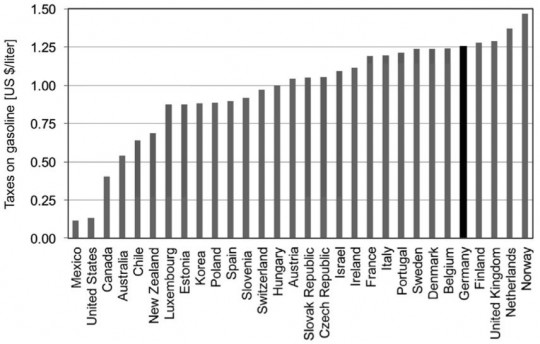
Advertisement
Safer roads: In all of Denmark in 2014, 170 people died in traffic (foot, bike and car combined). It’s the lowest figure ever recorded there. The country is aiming for 120 by 2020.
Fatality map: The Oregonian has mapped the 133 people who died while walking or biking in the Portland metro area between 2008 and 2012.
Teaching streets: After three years of advocacy, a Northern Virginia community is building a Dutch-style “traffic garden” where kids can learn safe biking, walking and driving in a realistic environment.
Camping fees: A national park in Maryland is closing a budget gap in part by raising hiker-biker site fees from $0 a night to $20.
Historical fantasy: Remember that year automakers issued a recall for every car ever sold on account of dangerous design?
Malls vs. biking: Bikeyface explains in two comic panels why bike users tend to shop on main streets.
Mountain bike trap: A 64-year-old woman in North Vancouver, B.C., is the alleged creator of a wire trap that clotheslined a mountain biker there in 2013. It’s a rare moment of actual violence in the area’s conflict between hiking and biking.
Violent clickbait: The apparently Seattle-based author of a post on the highly respected website Matadornetwork.com says that one of the seven rites of passage of living in Portland is to “daydream about driving cyclists off the road on a regular basis.”
Scofflaw self-interest: How many people who run red lights on bikes are doing it because it actually feels more safe?
Finally, your video of the week is a guide to being the most pretentious (but also culturally respectful!) bike lover you can be:
If you come across a noteworthy bicycle story, send it in via email, Tweet @bikeportland, or whatever else and we’ll consider adding it to next Monday’s roundup.

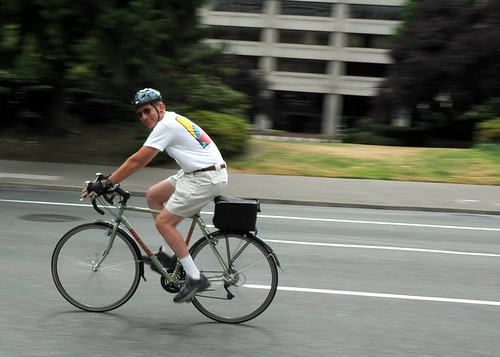
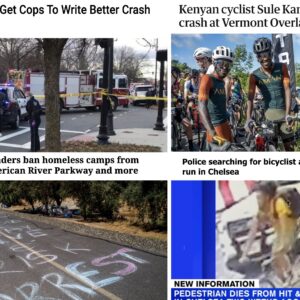
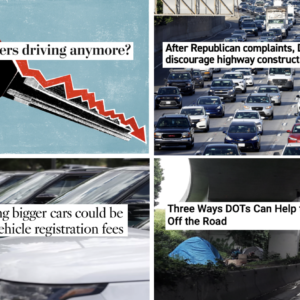
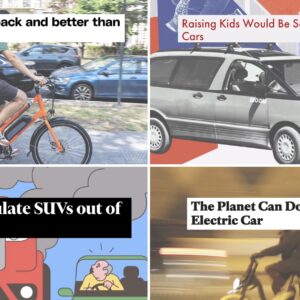
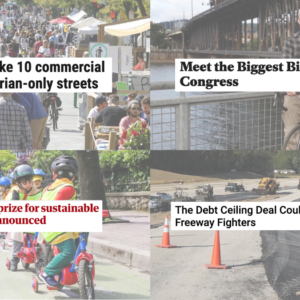
Thanks for reading.
BikePortland has served this community with independent community journalism since 2005. We rely on subscriptions from readers like you to survive. Your financial support is vital in keeping this valuable resource alive and well.
Please subscribe today to strengthen and expand our work.
Waze is very rude. It has shown routes on private property near Portland to get around construction.
Waze is also prone to show you many turns (the kind we get on bike maps or official routes) and turns in cars at more intersections with stop signs just leads to more opportunities for conflicts and mistakes. Turns in cars and turns on a bike are not the same thing by a long shot.
I love Waze for long road trips because it’s great at major rerouting when it’s really needed there (as well as heads up on hidden cops, debris in road or accident on the route ahead). But for in-city driving it’s annoying as hell.
The link in the section titled “Biking equity” is no good.
In a similar discussion as Denmark, Iceland had a total of four traffic related fatalities in 2014.
http://eurorap.org/partner-countries/iceland/
Also, the link to the hiker-biker article is broken.
Nevermind, seems to work now, but first gave an error message.
Iceland only has 323,000 residents. Still, the rate is impressive!
As is the Danish rate – it’s roughly a third of Oregon’s.
Iceland
4 deaths/323,000 population = .0012% about 1 in 83,000
Denmark
170 deaths/5,614,000 population = .0030% about 1 in 33,300
Oregon
352 deaths/3,990,000 population = .0088%, about 1 in 11,350
Thought of another way, if Oregon was as good as Denmark at traffic safety, about 230 of our friends and family who died in traffic would be alive today.
If we were as good as Iceland, and we’d have about 310 more alive.
The international standard used by the OECD is deaths per 100,000 population. It might make for easier discussion than those small percentages.
> Too-smart wayfinding? Waze and other smartphone apps that plan routes based on real-time traffic patterns are telling people in cars that they can save time by taking side streets. Neighbors don’t like it.
Just wait until computer-driven cars blindly follow the Waze wayfinding service. Google’s centralized system will become the de facto decider of all traffic flows in a city.
And then… watch the monumental backup as someone figures out how to trick all those cars into taking just one route across the Willamette (on the plus side, the other bridges would be that much quieter for people walking and biking!).
If the cars are self driving simply ride in front of them. A self driving car will never be aggressive or deliberately put a cyclist in danger. I can’t wait!
Google is aware of this issue. Passive programs have been/will be tweaked to make them less so.
Err, what gives you that idea, exactly? The automakers could totally program self-driving cars to follow a cyclists at say 3 feet behind you. And constantly rev the engine until you get out of the way.
Methinks you have read too much Asimov!
Future add in the back of Car and Rider magazine “This Google Car hack will shorten your trip times* by following within inches and revving the engine! *Average time saved 1.2 seconds per trip. Your experience may vary.”
The waze problem has an easy solution, it is called a diverter, installing them on non-arterial streets can prevent the problems.
Certain high-arterial bike routes aside (Ankeny, Clinton, etc), I wouldn’t want to see too many diverters going in all across Portland. What makes portland less prone to traffic is the very nature of overflow traffic spreading out across the grid. Put in too many diverters and we’re left with nothing but pocketed neighborhoods surrounded by arterial collectors – a pattern that raises the frustration of drivers and encourages speeding.
I’d say East Portland already has quite a few de facto diverters. We just can’t retrofit any of them as through routes for greenways.
The link for the “anti-aging” story is the URL for the traffic gardens link.
Sorry about that – fixed.
When I’m returning on Route 30 from Forest Park, I need to take a left at the traffic light at Kittridge. If there is no traffic coming, I do run the red because I feel unsafe sitting in the left turn lane as cars go roaring by, coming from behind. It’s pretty much the only traffic light I do it at.
I will occasionally run the red light turning left from nb Interstate on to Overlook in the evening. The bike symbol to rigger the light has been relocated (it used to be uncomfortably close to the MAX- unsettling but safe) to just a few inches from the motorist lane. If the traffic is light, people drive really fast through here, and the signal makes you wait through many phases. On dark or rainy evenings, I opt to run the light rather than take my chances waiting for it
I admit I ride pretty “scofflaw style”, and I have a number of reasons (justifications- you can decide) for such behavior aside from claiming lane space as mentioned in the above article.
The first being that I don’t trust drivers coming at me from behind, too many times I see people looking down at phones as they approach red lights. I definitely feel safer with the red light between us in this case.
Also it’s an issue of mobility. Standing there with a bike between my legs makes you pretty much unable to react to any situation that might present itself to you while waiting at a light. I am able to respond in a variety of ways while moving – I can brake, speed up, turn, or ditch if needed. Standing there my only option is to flinch.
Also you’re more visible if you are moving than if you are standing still. Motion is the only thing that your eyes can sense within your entire field of view.
Then of course raising my center of gravity I feel puts me in a better position if I should get hit. I suspect (not proven- just kind of common sense here) that being higher up if I was hit, puts me in a position of being thrown from the point of collision or lending on the hood of a car rather than being forced under the vehicle. And though not much, sharing the kinetic energy of the collision with a bike while mounted seems like it could lessen the damage one suffers if you were to be hit.
Why is correct pronunciation pretentious?
Here’s why correct pronunciation might be considered pretentious.
Elitism — you need to learn new words with new spellings and pronunciations. Then, learn to use them correctly in sentences. It’s a way of isolating outsiders from insiders. And to exhibit mild hazing of newcomers.
Non-elitism — ya don’t really care how someone pronounces things, or whether they gum up the context in a sentence. It’s more a matter of whether you want to carry on a conversation with someone with similar interests but possibly having different levels of background.
Trying to use any foreign language word in its native vowel and consonant pronunciation an English sentence is going to be a challenge. Is it worth it to try? Maybe, maybe not. Personally, I’m all in favor of learning new things, but not in expecting other folks to have a grip on some other language’s pronunciation patterns before I’m willing to engage in a conversation with them.
Still, it’s interesting to learn what the native pronunciation of all those bike manufacturers is.
My $0.02.,
Ted Buehler
The y axis on the gasoline graph measures the price at US $/liter. Since a liter is approximately one quart, that puts Norway’s gas tax at about $6.00/gallon. Wow! I couldn’t quite believe it, but further research confirmed that Norwegians pay over $10.00/gallon. The U.S. would come to a grinding halt overnight at that price. Rationing would be a better option.
The US would no more grind to a halt than Europe, countries in which have gas prices of that equivalent or higher. More likely is that we would adopt more sane policies towards transit and infrastructure than the present 1950s “bigger roads more cars” teen dream mentality that most of the country has currently.
Europe has very different urban and transportation structures from the US. Raising US gas taxes directly and disproportionation damages the less paid who commute farthest. We need transportation that works for the US, not failed attempted copies of what works in Europe. We have many nice and successful places in the US. We would gain by studying them.
Nobody said anything about copying europe, just that they have expensive gas and have managed not to crumble into oblivion like the previous commenter implied we would. Reread: “More likely is that we would adopt more sane policies towards transit and infrastructure than the present 1950s “bigger roads more cars” teen dream mentality that most of the country has currently.”
“We need transportation that works for the US, not failed attempted copies of what works in Europe.”
This is a dynamic problem. What works in Europe could work here. The point is to phase in these kinds of changes, not pretend like someone is suggesting we jack our gas tax rate ten-fold overnight. We do know, after all, how these variables (gas tax, infrastructure quality, mode share) are related.
On the Matt Staff article about Driving Cyclists off of the Road in Portland:
I just posted the following on the Matador Network’s FB page. Please feel free to add your comments there (https://www.facebook.com/matadornetwork):
As a Portlander, I guarantee that I’ve never: “Daydream(ed)about driving cyclists off the road.” Please don’t fantasize about hurting me, my family, or my friends.
I’m sorry to read that Matt Staff feels otherwise. I’m sorry to read that Matador supports these dangerous (And not funny) articles.
http://matadornetwork.com/life/7-rites-passage-everyone-will-experience-portland/
Bishop charged in cyclist death to remain in Baltimore jail
http://www.seattlepi.com/news/crime/article/Bishop-charged-in-cyclist-death-to-remain-in-6010068.php
Finally charged -good, I’ve been watching that story for about two weeks now.
A slight correction to the German Bike Challenge piece.
Participating elected officials not only agree to leave their private car at home, but are encouraged to park their city-issued vehicle in the town square, covered with a tarp, for the duration of the three-week annual contest. The contest is specifically not a commute challenge but a do-without-your-car-at-home-and-at-work-and-in-between challenge.
Haha, as peewee Herman would say… “Portland” in the Oregonian maps blurb… Haha. 🙂
(Potland) autocorrect error.
$20 for a bike / hike camping spot — the same as for car camping — is ridiculous. It better be the nicest bike/hike spot in the whole National Park system for that amount of money.
On the plus side, the cyclists can now just reserve a full RV spot for the same price. If enough people do that, they may end up changing the policy.
Yes, folks, that $0.12 per liter is the weighted average of gas taxes countrywide. Diesel is slightly higher, about $0.15.
So much for taxing users according to costs.
Not only will Waze send drivers into your neighborhood, those drivers, unfamiliar with the route, will be in the now-familiar GPS pose, piloting tons of steel while dividing their attention between the road and the phone held down low in their right hands.
I saw one of those a few weeks ago, weaving in and out of the bike lane, blatantly enough that I thought it was drunk driver. As she passed me, I could see that she was looking down at her right hand, and I assumed she was texting. The passenger window was open, so at the next light, I spoke up (I know, confrontation’s not the best idea, but I was more or less civil).
“Don’t text and drive–you’re weaving.” I I said just before the light turned green.
She caught up to me just beyond the intersection, and, while still moving forward, gave me her full attention, leaning across the passenger seat (still going forward, but glaring at me instead of watching ahead), holding her phone up so I could see the tiny map on the screen.
“I’m not texting, idiot,” she screamed at me. “I’m navigating.”
Oh, well then, that’s better.
CNN article links automobile use to terrorism:
“He’s a big mama’s boy, you know. His best friend is his kitty cat. There’s no way he could have carried out any kind of terrorist plot,” Cornell’s father said. “He didn’t even drive; he didn’t have a car.”
http://www.cnn.com/2015/01/15/us/capitol-attack-plot/index.html